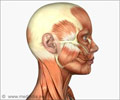A treatment for muscular dystrophy may be within view after US scientists reported Sunday they used stem cell transplants to improve muscle function in mice afflicted with the disease.
A treatment for muscular dystrophy may be within view after US scientists reported Sunday they used stem cell transplants to improve muscle function in mice afflicted with the disease.
This is the first time transplanted embryonic stem cells have been shown to restore defective muscles in mice models of the wasting disease, according to the study."We envision eventually developing a stem-cell therapy for humans," said University of Texas molecular biologist Rita Perlingeiro, who led the research.
"These cells can be transplanted into the muscle, and they cause muscle regeneration," she said, adding that any therapy for humans was still years away.
Muscular dystrophy is an umbrella term covering nearly a dozen genetic, degenerative diseases that primarily affect muscles.
The condition, which afflicts mainly males, is caused by an absence of dystrophin, a protein essential for keeping muscle cells intact and alive.
The most common childhood form, Duchenne muscular dystrophy, shows up at age three or four. Its victims rarely live into their thirties.
Advertisement
"The problem has been that embryonic cells make everything," said Perlingeiro. "The trick is to pull out only the one type you want."
Advertisement
In a first set of experiments, the results were mixed.
"We grew muscle in vitro -- in the Petri dish -- but when we injected the cells into the mice there were still some left-over undifferentiated cells, and these caused tumours," Perlingeiro told AFP.
To filter out all the unwanted cells, the researchers used fluorescent dyes that made it easier to identify the different types of cells.
This time, when the purified batch of muscle cells was injected into the hind legs of mice with muscular dystrophy, the cells penetrated deep into the muscle, an indication that they were growing and reproducing as intended.
Many of the muscle fibres also contained the all-important dystrophin that is lacking in muscular dystrophy patients.
In tests measuring muscle development, the muscles contracted with three times as much force as control mice who had the disease but had not been given the treatment. The results were in fact closer to normal mice, the study reported.
And even after three months, there were no tumours.
The next step, said Perlingeiro, is to extend the same technique to humans. "We should be able to use the same strategy," she said.
Combining these findings with recent breakthroughs in the generation of pluripotent stem cells from adult human skin -- thus avoiding the ethical quandaries of using human embryo stem cells -- would hasten the process, she said.
Source-AFP
LIN/S









